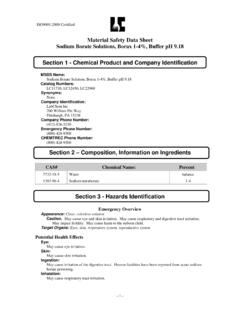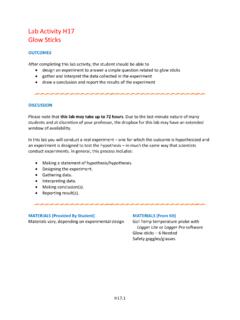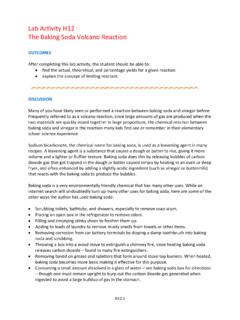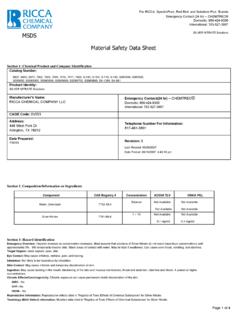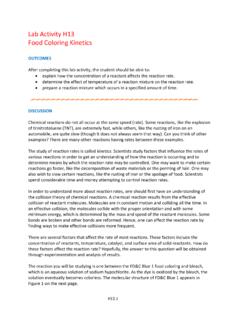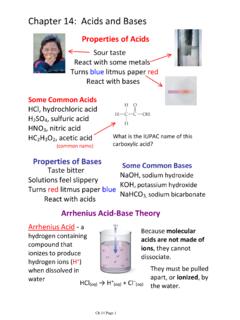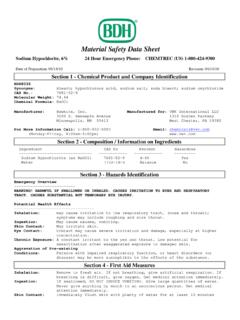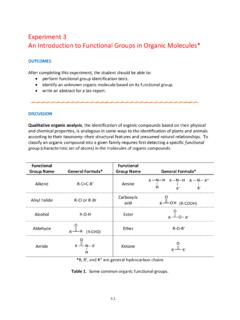Transcription of Chapter 10: Chemical Bonding - Anoka-Ramsey Community …
1 An understanding of howand whyatoms attach together in the manner they do is central to chemistry Chemical Bonds are the attractive forcesthat hold atoms together in more complex TheoryEmphasizes the importance of valence electrons VALENCE ELECTRONS-electrons in the outermost shell-ARE THE ELECTRONS INVOLVED IN BONDINGUses dotsto represent valence electrons either ONor SHAREDby atomsBonding between atoms occurs by either transferor sharing of electronsto achieve outer shells with 8 electrons (exceptions: Li, Be and He) lewis Electron Dot SymbolsUses symbol of element to represent the nucleus and inner (core) electrons (Put one electron on each side first, then pair)Uses dots around the symbol to represent valence electrons Remember that elements in the same grouphave the same number of valence electrons; therefore, their lewis dot symbols will look 10: Chemical Bonding Ch 10 Page 1 Noble gases are considered stable because they do not react with other elements.
2 This stability is attributed to their FULL VALENCE SHELLS-they have a complete OCTET of ELECTRONS (exception: helium)He: 1s2Ne: 1s22s22p6Ar: 1s22s22p63s23p6Kr: 1s22s22p63s23p64s23d104p6Xe: 1s22s22p63s23p64s23d104p65s24d105p6 Atoms of many elements that LACKa complete octet of electrons in their outer shells react in such a way to attain may loseor gainelectrons depending on the type of element the atom is (metalor nonmetal) Ion formation occurs when atoms of two elements (a metaland nonmetal) are present. Recall: When a neutral atom loses or gains one or more electrons an ion is formed. The metalwill lose one or more electrons - forms a cationThe nonmetal will gain one or more electrons - forms an anion Arsenic b) Iodine c) Silicona)Write the lewis symbol for:Formation of Ionic CompoundsLi :F: Li+[:F:] Lithium cationfluoride anion+Ionic Compounds: Electrons Transferred Ch 10 Page 2 Li :F: Li+[:F:] Lithium cation fluoride anionLi: 1s22s1F: 1s22s22p5+Li+: 1s2F.
3 1s22s22p6Li+has a full valence shell -it has an electron configurationjust like He F-has a full valence shell (a complete octet) - it has an electron configuration just like Ne Show how the following ionic compounds form using lewis Electron Dot )K3P b)MgBr2c)Covalent BondsMost nonmetal elementstry to achieve a NOBLE GAS CONFIGURATION by sharing electrons with other nonmetals Covalent Bonding results from the SHARINGof one or more electron pairs between atomsExample: H wants to be like He wants to be like Ar :Cl:H :Cl: By sharing e-s, bothattain a noble gas configurationFormation of Ionic Compounds Ch 10 Page 3 H :Cl: can also be written asH -Cl: The HCl molecule has 1 Bonding pair of electronsand 3 nonbonding pairs of electrons(also called "lone pairs") to the octet rule) "OCTET RULE" (Note: there are exceptionsNonmetal atoms share electrons to complete their octet, called: Completing octets may involve sharing electrons with multiple atoms or sharing multiple pairs of electronswith the same atom.
4 In lewis theory: Nonbonding e-pair Single covalent bonds Atoms share one pairof electrons (carbon sharing e-s with multiplehydrogen atoms)Double covalent bondAtoms share two e-pairs Triple covalent bondAtoms share three e-pairsCovalent lewis Structures Ch 10 Page 4 Decide on the central atom (it will neverbe H or F).1.(The central atom is usually the one that is by itself)Add 1e-for a -1 charge, add 2e-for a -2 charge, Subtract 1e-for a +1 charge, subtract 2e-for +2, If the structure is an ion: Determine the total number of valence electronsin the covalent bonds between the central atom and the surrounding atoms -called the "skeletal structure ". Count how many electrons have been used to form these used to form covalent bonds from total number of valence electrons in the molecule or ion to determine how many electrons remain (if any).
5 Remaining electrons become lone pairs, FIRST ON THE OUTSIDE ATOMS to complete their octets, and then on the central any atoms that need an octet of electrons do not have it, form double and triple bonds as necessary by bringing outer atomlone pair electrons down between two atoms so they can share Important: C, N, O and F alwaysfollow the octet ruleWrite the lewis structure for NH3 Central atom? electrons? skeletal electrons? structure ? for Writing lewis Structures for Covalent Compounds Ch 10 Page 5 C, N, O and F ALWAYS have 8 electrons surrounding them in their lewis structures. They alwaysfollow the octet : Boron may have less than 8e-s (usually 6).
6 Phosphorus and atoms of higher atomic number have AT LEAST 8e-s but sometimes can have more that 8e-s in lewis structures. These are elements that can be exceptions to the octet rule. We will not write lewis structures of this the lewis Structures for the following molecules and polyatomic )O2c)CH2Ob)CO2d)Writing lewis Structures Ch 10 Page 6 Write the lewis Structures for the following molecules and polyatomic ions (continued).HCNe)SO32-f)NH2Br2+g)Resonan ce StructuresWrite the lewis structures of:SO2a) In this situation, no oneLewis structure can adequately describe the actual structure of the molecule. The actual molecule or ion will have characteristics of all the valid lewis structuresthat can be drawn.
7 (It is a hybridof these lewis structures). Sometimes we can draw more than one valid lewis structure for a molecule or polyatomic ion. HCO2-b)Resonance Structures Ch 10 Page 7 A molecule or ion will be most stablewhen the electron pairs or groups are as far apart as possible. The most important factor in determining the shape of a molecule or polyatomic ion is the relative repulsion between electron of Electron "Groups"around the Central AtomExample Electron Geometry & Molecular Geometry O C O 2 Linear3 Trigonal Planar4 Tetrahedral (Molecular Geometry = Shape of Molecule)Shapes of Molecules Ch 10 Page 8 Valence Shell Electron Pair Repulsion (VSEPR) Theory:Repulsion between the negative charges on electron groups determines the molecular geometry (shape) of a molecule or polyatomic ionNH3a)HHNH 1st- Determine the lewis structure of NH3 Determine the Electron and Molecular Geometry of.
8 2nd-Count electron "Groups" around the central atom3rd-Determine Electron Geometry then Molecular GeometryElectron GeometryTetrahedral4 Four electron groups are at the corners of a tetrahedronMolecular GeometryTrigonal PyramidalH2Ob)Determining Molecular Geometry Using VSEPR Theory Ch 10 Page 9 HOH lewis structure of H2O4 Groups of ElectronsElectron Pair Geometry = TetrahedralMolecular Geometry = BentDetermine the Electron and Molecular Geometry of:CCl4a)HCNb)Determining Molecular Geometry Ch 10 Page 10 Determine the Electron and Molecular Geometry of:CH2Sc)SO2d)H2Se)PH3f)Practice for next class:Bond PolarityOne atom pulls the electrons in the bond closer to its side. One end of the bond has larger electron density than the other.
9 The result is aPOLAR BOND Bonding between unlike atomsresults in unequal sharing of the end with the larger electron densitygets a partial negative charge ( -)and the end that is electron deficient gets a partial positive charge ( +). H Cl +:Example: HClBond Polarity Ch 10 Page 11 ElectronegativityElectronegativity is a measure of relative attractionthat an atom has for the shared electrons in a covalent bondHow can we determine which atom is + and which is -Use electronegativity values of the atoms in a polar bond?Increasesacross the period (left to right) Decreasesdown the group (top to bottom) ElectronegativityThe larger the difference in electronegativity, the more polar the Ch 10 Page 12 Electronegativity difference between zero and Many times between two identical atoms Nonpolar Covalent Bond Electronegativity differencebetween and 2 Between two different NONMETAL atoms Polar Covalent BondExample: + H F -Electronegativity difference is greater than 2 Primarily exists between METALS and NONMETALS Ionic BondMain Classes of Chemical Bonds Ch 10 Page 13 Can show the direction of bondpolaritywith + and -and/or a special arrow:Show the direction of bond polarityfor the bond in HCl.
10 AND It musthave polar bonds It musthave an unsymmetricalshapeIn order for a MOLECULE to be polar:If there are no polar bonds, then molecule is NONPOLARFFM olecule is NONPOLAR If there arepolar bondsandthe bond dipoles cancel outMolecule is POLAR If there are polar bonds andthe bond dipoles DO NOTcancel out, Polar Molecules Ch 10 Page 14 NH3c)ONCl lewis StructureDetermine whether the following molecules are POLAR or )CH2F2b)NOCl d)Molecular Polarity Ch 10 Page 15 Molecular Polarity Affects SolubilityPolar molecules are attracted to other polar molecules (Many ionic compounds dissolve in water as well).Since water is a polar molecule, other polar molecules dissolve well in water Nonpolar molecules are attracted to other nonpolar molecules and dissolve in each other "LIKE DISSOLVES LIKE"Molecular Polarity and Solubility Ch 10 Page 16
